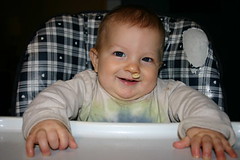For the introduction to the book project I'm working on--on how modernism was used as a Western propaganda tool in the early years of the Cold War--I'm thinking more and more that I've got to immerse myself in the theory about what modernism actually is. I've been thinking about it, and admittedly oversimplifying it, largely in terms of style and formal features of art: streamlining and the elimination of ornament, attention to the ways that humanity perceives the world (using Freud, Einstein, etc.) and attempts to undermine traditional means of representation, a sense of crisis and all of our conceptual frameworks breaking down, attention to the ways that machines are changing and reorganizing humans' daily lives and ways of relating to each other. And so when I've been writing and talking about it in this project, I've been taking for granted that those things are "modernism." But this, of course, manages to ignore a vast amount of criticism and theory, beginning back in the 1910s at the latest, about what "modernism' might be beyond a collection of stylistic features and thematic concerns. So I'm starting to read the big theory books on modernism: Levenson's GENEALOGY OF MODERNISM, Eistensson's CONCEPT OF MODERNISM, Bürger's THEORY OF THE AVANT-GARDE, Huyssens' AFTER THE GREAT DIVIDE, Berman's ALL THAT IS SOLID MELTS INTO AIR. So what I'm trying primarily to figure out is:
How did modernism, a style or movement or collection of movements or just a historical moment that is so frequently, and so dominantly, understood as having been born in diametric opposition to bourgeois liberal capitalism BECOME the house style of corporate America, of the national-security state, by the 1950s?
Now, just in the formulation of that question there are a ton of questions. Is there such a thing as "modernism" that stays the same between Manet and Flaubert and the 1950s? Was modernism ever oppositional? Certainly such movements as Dada and Vorticism sought, in their now-quaint-seeming ways, to undermine bourgeois society, but was modernism ever ACTUALLY oppositional in the way that Adorno and Horkheimer thought it was? And was modernism ever actually the "house style" of the powerful? (I think this last is the easiest one to prove, and I look forward to really engaging with DIALECTIC OF ENLIGHTENMENT ont hat question.
So, I've got a big stack of books next to the bed that I'm hoping to work my way through over the summer. Nothing as fun as last summer's reading (no novels, sadly), but in addition to my modernism independent study I've got Rajiv Chandrasekharan's IMPERIAL LIFE IN THE EMERALD CITY (about the Coalition Provisional Authority and the construction of the Green Zone in Baghdad) and Thomas Carlyle's history of the French Revolution, the Modern Library edition of which I picked up at our neighborhood's collective garage sale.




